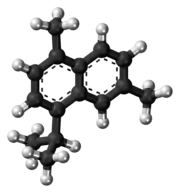Cadalene
Cadalene or cadalin (4-isopropyl-1,6-dimethylnaphthalene) is a polycyclic aromatic hydrocarbon with a chemical formula C15H18 and a cadinane skeleton. It is derived from generic sesquiterpenes, and ubiquitous in essential oils of many higher plants.[1]
 | |
 | |
| Names | |
|---|---|
| IUPAC name
4-Isopropyl-1,6-dimethylnaphthalene | |
| Preferred IUPAC name
1,6-Dimethyl-4-(propan-2-yl)naphthalene | |
| Other names
Cadalin | |
| Identifiers | |
3D model (JSmol) |
|
| ChemSpider | |
| ECHA InfoCard | 100.110.415 |
PubChem CID |
|
| UNII | |
CompTox Dashboard (EPA) |
|
| |
| |
| Properties | |
| C15H18 | |
| Molar mass | 198.30342 |
| Appearance | Colorless liquid |
Except where otherwise noted, data are given for materials in their standard state (at 25 °C [77 °F], 100 kPa).
Infobox references | |
Cadalene, together with retene, simonellite and ip-iHMN, is a biomarker of higher plants, which makes it useful for paleobotanic analysis of rock sediments.
The ratio of retene to cadalene in sediments can reveal the ratio of the genus Pinaceae in the biosphere.[2]
References
- Gomes, Alexandre de O.; Azevedo, Débora de A. (2003). "Aliphatic and aromatic hydrocarbons in tropical recent sediments of Campos dos Goytacazes, RJ, Brazil". Journal of the Brazilian Chemical Society. 14 (3): 358. doi:10.1590/S0103-50532003000300004.
- Hautevelle, Y.; Michels, R.; Malartre, F.; Trouiller, A. (2005). "Vascular plant biomarkers as ancient vegetation proxies and their stratigraphic use for tracing paleoclimatic changes during Jurassic in Western Europe" (abstract page). Geophysical Research Abstracts. 7: 10201.
This article is issued from Wikipedia. The text is licensed under Creative Commons - Attribution - Sharealike. Additional terms may apply for the media files.